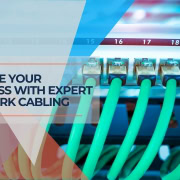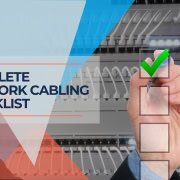Building a Future-Proof Network for Your New Home: The 2024 Guide
As new technologies continue to shape how we live and work, a reliable home network has become essential. For those building new homes, planning a network that can support the increasing demands of modern devices is a practical step toward long-term convenience.
This guide provides clear, actionable insights on building a network in new construction homes. It covers key topics like the advantages of Cat6 cables, fiber optics, and the latest Wi-Fi 7 technology. By incorporating solutions like Unifi IT products, you can ensure your home network will be ready for the future.
| Key Point | Details | Why It Matters |
|---|---|---|
| Use Cat6 for Shorter Runs | Cat6 cables are reliable for distances under 328 feet, and support speeds up to 10 Gbps. | Cat6 is affordable, widely available, and future-ready for most home applications. |
| Fiber Optics for Longer Distances | Use fiber optic cables for runs over 300 feet to prevent signal degradation. | Fiber ensures high-speed, uninterrupted data transmission for large homes or external buildings. |
| Install Wi-Fi 7 Access Points | Wi-Fi 7 offers faster speeds, more device capacity, and lower latency. | Future-proofing your home with Wi-Fi 7 ensures seamless connectivity for years to come. |
| Plan a Network Closet or Rack | Centralize routers, switches, and patch panels in one location. | A well-organized network closet simplifies management and allows room for future expansions. |
| Future-Proof with Flex Tubing | Install flex tubing during construction for easy cable upgrades later. | Flex tubing allows you to upgrade cables as technology evolves, saving time and money. |
| Consider Wired Solutions for Wi-Fi Dead Zones | Pull Ethernet drops to areas with concrete walls or thick barriers. | Wired access points ensure strong, reliable connections in difficult-to-reach rooms. |
| Outdoor Wi-Fi Requires Dedicated Access Points | Install outdoor-rated access points for patios, pools, and gardens. | Keep your outdoor areas connected without signal drop-offs or performance loss. |
Table of Contents
- 1 The Foundation: Planning Your Home Network
- 2 Understanding Cabling Options: Why Cat6 and Fiber Optics?
- 3 Future-Proofing with Wi-Fi 7
- 4 Building the Heart of the Network: Your Network Closet
- 5 Solving Common Wi-Fi Challenges
- 6 Outdoor Wi-Fi and Entertainment
- 7 Future-Proofing Tips for Your Home Network
- 8 Building the Ideal Home Theater
- 9 Managing and Monitoring Your Home Network with Unifi
The Foundation: Planning Your Home Network
When building a new home, setting up your network infrastructure early can save time and prevent costly adjustments later. A well-planned network will support everything from streaming devices to smart home systems, providing reliable home connectivity.
Key Components of a Home Network
A typical home network consists of several essential elements: routers, switches, access points, and structured cabling. Routers manage the connection to the internet, while switches distribute this connection across various devices. Access points extend Wi-Fi coverage, and structured cabling (like Cat6 or fiber optics) ensures fast, stable connections to stationary devices like TVs, gaming consoles, and security cameras.
These components work together to create a system that supports multiple devices without compromising speed or reliability. Proper planning ensures that this system will meet your current needs and allow for future expansion as technology evolves.
The Role of Unifi IT Solutions in 2024
Unifi IT Solutions offers a range of products designed to simplify home network management. Their 2024 lineup includes advanced Wi-Fi 7 access points, switches, and controllers, allowing centralized network control. This can be particularly useful for larger homes, where managing multiple devices and ensuring even coverage across different rooms and outdoor spaces becomes more challenging.
Unifi’s ecosystem offers an integrated solution, allowing users to monitor network performance, troubleshoot issues, and manage access points—all from a single platform.
Understanding Cabling Options: Why Cat6 and Fiber Optics?
Cabling remains critical to building a reliable home network, even as wireless technology improves. Choosing the right cables during construction can significantly improve network performance, especially when handling high-bandwidth tasks like streaming or gaming.
The Importance of Structured Cabling
Structured cabling is still the backbone of a stable home network. While Wi-Fi has become faster and more efficient, wired connections provide unmatched reliability, speed, and security for devices that demand consistent performance. These include desktop computers, home security systems, and entertainment centers.
By planning your network cabling during construction, you can ensure that all key areas of the house, from living rooms to home offices, are equipped with the infrastructure to handle future technological needs.
Why Cat6 Is the Standard for New Homes
Cat6 cabling is the recommended standard for most new homes. It supports up to 10 Gbps speeds and provides ample bandwidth for everyday tasks like video streaming, smart home device management, and large file transfers. Its affordability and availability make it a practical choice for residential builds.
Cat6 cables are also future-ready for most residential applications, ensuring your network won’t require significant upgrades as new technologies emerge. Installing Cat6 throughout your home is a cost-effective way to secure high-speed internet access in every room.
When to Use Fiber Optic for Long Cable Runs
Fiber optic cables are a more reliable option for cable runs longer than 300 feet (328 feet to be exact). Fiber optics can transmit data over greater distances without the signal degradation that occurs with copper-based cables like Cat6. This makes fiber ideal for large homes or properties requiring longer distances between network devices, such as from the house to an external building or garage.
While fiber optic cables are more expensive to install, they offer superior speed and future-proofing, making them a worthy investment in scenarios where distance and performance are critical.
Future-Proofing with Wi-Fi 7
As homes become more connected, wireless technology is advancing to keep pace. Wi-Fi 7, the latest wireless standard, significantly improves speed, capacity, and overall performance. For anyone building a new home, planning around Wi-Fi 7 ensures that your network will be ready to handle the increasing demands of modern devices.
What Is Wi-Fi 7, and Why Is It Ideal for New Homes?
Wi-Fi 7 brings several advancements over previous generations. It supports much faster speeds—up to 46 Gbps in ideal conditions—and can handle more devices on the network without congestion. This makes it particularly valuable in homes connected to multiple devices, such as smartphones, smart TVs, home automation systems, and security cameras.
Additionally, Wi-Fi 7 improves latency, meaning better performance for real-time applications like gaming, video conferencing, and streaming. For new homes, installing access points that support Wi-Fi 7 ensures that your network will be prepared for future devices and applications.
The Role of Unifi Wi-Fi 7 Access Points
Unifi’s 2024 lineup includes several Wi-Fi 7 access points designed to provide seamless coverage across large or multi-story homes. These devices easily integrate with Unifi’s broader ecosystem, allowing you to manage everything from a single interface.
Installing Unifi Wi-Fi 7 access points in key locations throughout your home, such as living areas, home offices, and entertainment spaces, ensures consistent coverage and high-speed performance. Their latest models also offer real-time monitoring and mesh capabilities for larger properties.
Positioning Access Points for Maximum Coverage
Strategic placement of access points is essential for avoiding Wi-Fi dead zones. In homes with open floor plans, placing access points in central locations helps ensure strong coverage throughout the space. For more complex layouts or homes with concrete walls (such as home theaters or basements), additional access points or wired solutions may be necessary to maintain a strong signal.
Outdoor areas, such as patios and pools, can also benefit from dedicated access points to extend outdoor entertainment or smart home device coverage.

Building the Heart of the Network: Your Network Closet
The network closet (IT Room) is central to every well-planned home network. This is where all the essential equipment—routers, switches, and patch panels—come together. Properly setting up the network closet during construction ensures that your network will be efficient, organized, and easy to manage.
What Is the Network Closet?
The network closet is the hub where all network cables converge. It typically houses the router that connects your home to the internet; network switches that distribute connectivity across devices, and patch panels that organize the various cables running through your home.
Locating the network closet in a central or easily accessible area, such as a basement or utility room, ensures that all house parts can be connected efficiently. This space should be planned with enough room to accommodate future expansions, such as additional switches or storage devices.
Wiring the Network Closet: Best Practices
When setting up the network closet, it’s important to label and organize cables carefully. Cat6 and fiber optic cables should be routed cleanly to prevent tangling and ensure easy maintenance. One practical practice is to use patch panels to connect the various cables running from different rooms neatly. This allows for quick changes or troubleshooting if an issue arises with a specific connection.
During construction, cables should be wrapped in plastic or other protective materials to shield them from dust, drywall debris, and damage. This ensures that your network remains fully functional after all the construction work is completed.
Integrating Coax for Flexibility
Even as streaming services grow more popular, some homeowners still prefer to maintain coaxial connections for traditional cable TV. By integrating coaxial cabling alongside Cat6 or fiber optics, you can choose between cable TV and streaming or even switch between the two.
Solving Common Wi-Fi Challenges
Wi-Fi performance can vary significantly depending on your home's structure and each room's layout. Understanding these challenges and planning around them ensures that your entire house remains well-covered, even in difficult areas.
Overcoming Wi-Fi Obstacles: Concrete Walls
Wi-Fi signals often struggle to penetrate homes with concrete-enclosed rooms—such as basements or home theaters. Concrete is a known blocker of wireless signals, which can lead to poor connectivity in specific areas. In such situations, relying on wireless solutions alone might not be sufficient.
The best way to ensure coverage in these areas is to pull Ethernet drops directly into the room and connect a low-profile access point. This allows the Wi-Fi signal to stay strong, even within the thick walls of a concrete-enclosed space. Installing wired access points in difficult rooms allows you to maintain stable internet access without relying solely on wireless connections.
Large, Open Spaces: Wi-Fi Overlap and Coverage
The lack of walls in homes with open floor plans makes it easier for Wi-Fi signals to travel uninterrupted. However, large spaces still need strategic placement of access points to avoid weak spots. For example, placing access points in central areas of large rooms ensures that Wi-Fi signals overlap, creating a continuous network without any gaps in coverage.
Wi-Fi 7 access points, especially when strategically placed, can handle the demands of large spaces more efficiently, ensuring that multiple devices can stay connected with minimal interference.
Why Mesh Networks May Not Be the Best Solution
While mesh networks are marketed as convenient, they may not always provide the best performance in larger homes or homes with specific challenges, such as concrete walls. Mesh systems rely on wireless backhauls to extend coverage, which can result in reduced speeds, particularly in areas farther from the primary router.
In contrast, wired access points connected through Ethernet cables offer faster, more reliable coverage, especially in homes where Wi-Fi signals struggle to penetrate walls or extend across multiple floors. By prioritizing wired access points, homeowners can avoid the performance drop-offs often associated with mesh networks.

Outdoor Wi-Fi and Entertainment
In modern homes, outdoor spaces are often just as connected as indoor ones. Whether you're streaming music by the pool, controlling smart lighting on the patio, or simply checking emails while relaxing outside, strong Wi-Fi coverage is essential for seamless outdoor entertainment and functionality.
Planning for Outdoor Wi-Fi Coverage
Extending Wi-Fi coverage outdoors requires thoughtful planning, especially in homes with large backyards, patios, or pool areas. Unlike indoor spaces, outdoor environments are more exposed to elements like walls, windows, and weather conditions affecting Wi-Fi signals.
Installing dedicated outdoor Wi-Fi access points is highly recommended to ensure reliable outdoor coverage. Unifi offers outdoor-rated access points designed to withstand weather conditions while broadcasting a strong signal. Positioning these access points near high-use areas, such as patios or entertainment zones, ensures uninterrupted coverage.
Integrating Outdoor Wi-Fi with Your Indoor Network
Seamless connectivity between indoor and outdoor spaces is key. By integrating outdoor access points into the broader home network, homeowners can move freely between indoor and outdoor areas without experiencing a drop in Wi-Fi signal. For instance, placing a Unifi outdoor access point near the pool or garden allows smart devices, like Sonos speakers or outdoor TVs, to remain connected without lag or signal drops.
This integrated setup is especially beneficial for those who entertain outdoors or rely on smart home automation systems for outdoor security and lighting. Linking these systems to the same network as indoor devices simplifies management and improves overall network reliability.
Future-Proofing Tips for Your Home Network
Building a network that can handle current demands is important, but planning for future upgrades is just as crucial. With technology rapidly evolving, a few thoughtful design choices during construction can save you from needing major upgrades later.
Running Tubes (Conduits) for Future Cabling
One of the best ways to future-proof your home network is to install flex tubing from your network closet to key areas like the attic, entertainment zones, and high-traffic rooms. Flex tubing allows you to add or upgrade cables as new technologies emerge easily.
For example, if you decide to install additional security cameras or upgrade from Cat6 to fiber optic cables in the future, having pre-installed tubes makes it easy to pull new wires without the need to tear them into walls. The upfront cost of installing these tubes is minimal compared to their long-term convenience.
Using Flex Tubing for TVs, Cameras, and Access Points
Flex tubing isn’t just for future upgrades; it can also be installed around key devices like TVs, access points, and outdoor cameras. Running tubing between TV locations or around entertainment centers allows you to add additional cables (such as HDMI or Ethernet) as your needs change.
For access points, flex tubing allows for easy upgrades in the future if you decide to switch from Cat6 to fiber or move to a newer Wi-Fi standard. This setup ensures your home can keep up with future technology without cutting holes in the wall.
Preparing for Future Technologies: Wi-Fi 7 and Beyond
While Wi-Fi 7 is the current cutting-edge technology, planning for what’s next is always wise. Installing network infrastructure supporting faster speeds and new standards, such as multi-gigabit switches and routers, allows your home to grow with future advancements.
Incorporating these future-proofing elements ensures your network remains relevant and capable for years to come.

Building the Ideal Home Theater
Integrating home theaters into your home network is key to creating a smooth, connected entertainment experience as they become more popular. However, network planning for home theaters involves unique challenges, especially when dealing with concrete walls or large rooms that require more than basic Wi-Fi coverage.
Wired Solutions for Home Theaters
Home theaters often feature heavy, concrete walls to enhance soundproofing and immersion. While excellent for movie-watching, these walls can significantly block Wi-Fi signals, making maintaining a reliable connection inside the room difficult. To solve this, it's best to install wired solutions.
Pulling Ethernet drops directly into the home theater and connecting them to low-profile access points or wired devices, such as media servers and streaming players, ensures uninterrupted streaming and control. Using Cat6 or fiber optic cables, you can deliver a consistent, high-speed connection that supports 4K and 8K content streaming, gaming, and smart theater controls.
Streaming and Entertainment
A wired connection benefits streaming services, gaming consoles, and smart home devices in your theater. A hardwired setup reduces buffering and provides the bandwidth for multiple devices to run simultaneously without lag. This is especially important for home theaters, where high-definition content and immersive audio experiences are standard.
When planning your network for a home theater, thinking ahead about future upgrades is helpful. For example, adding flex tubing near the projector or TV area allows you to easily add or replace cables for new technologies, ensuring that your theater remains at the forefront of home entertainment.
Managing and Monitoring Your Home Network with Unifi
Once your home network is installed, managing and monitoring it efficiently is key to maintaining optimal performance. Unifi IT Solutions provides a user-friendly platform allowing homeowners to easily oversee their network, ensuring everything from Wi-Fi strength to device connectivity runs smoothly.
Centralized Management with Unifi Network Controller
Unifi's Network Controller is an intuitive tool that lets you manage all aspects of your network from a single dashboard. Whether you're monitoring the performance of your Wi-Fi 7 access points, adjusting settings on your switches, or troubleshooting issues with devices, Unifi’s platform gives you centralized control.
This central management system is especially valuable for larger homes with multiple access points, cameras, and smart devices. It allows you to configure security settings, manage bandwidth allocation, and even set up guest networks—all from your smartphone or computer.
Setting Up Alerts for Network Health
With Unifi, you can configure real-time alerts to monitor your network's health. If an access point goes offline or bandwidth usage spikes unexpectedly, you'll receive notifications allowing you to address issues before they become significant problems.
This level of visibility helps prevent disruptions in your home network, making it easier to maintain a consistent, reliable connection throughout the house. Additionally, Unifi’s tools include regular firmware updates to ensure your equipment remains secure and performs at its best.
Conclusion
Building a reliable and future-proof network for your new home is an investment in convenience, connectivity, and long-term savings. By carefully selecting your cabling, planning your network closet, and incorporating the latest technologies like Wi-Fi 7 and Unifi IT Solutions, you can create a network that meets today’s needs and is ready for whatever the future holds.
If you have any questions or need help designing your home network, feel free to contact us. We’ll be happy to assist you.











Leave a Reply
Want to join the discussion?Feel free to contribute!